I had been struggling with this parallax effect for a little while. I wouldn't have done it without @Fogmeister instructions, though I still had to figure out a couple of things by myself.
Anyway, here is a Swift 2.0 version, (hopefully a bit more complete):
import UIKit
class ViewController: UIViewController, UIScrollViewDelegate {
var backgroundScrollView: UIScrollView!
var contentScrollView: UIScrollView!
var imageView: UIImageView!
var contentView: UIView!
var maxContentOffset: CGFloat!
var maxBackgroundOffset: CGFloat!
var cvbw: CGFloat!
var page: Int = 1
override func viewDidLoad() {
super.viewDidLoad()
self.createBackground()
self.createContent()
}
func createBackground() {
self.imageView = UIImageView(image: UIImage(named: "ParalaxMaterial.jpg")) //ParalaxMaterial.jpg is of size: 2500 x 2668px
self.imageView.frame = CGRectMake(0, 0, ((self.view.bounds.height/2668) * 2500), self.view.bounds.height)
self.backgroundScrollView = UIScrollView(frame: view.bounds)
self.backgroundScrollView.backgroundColor = UIColor.redColor()
self.backgroundScrollView.contentSize = imageView.bounds.size
self.backgroundScrollView.addSubview(self.imageView)
self.view.addSubview(self.backgroundScrollView)
self.maxBackgroundOffset = self.maxOffsetForScrollView(self.backgroundScrollView)
}
func createContent() {
self.contentView = UIView(frame: CGRectMake(0, 0, (self.view.bounds.width * 3), self.view.bounds.height))
self.contentScrollView = UIScrollView(frame: view.bounds)
self.contentScrollView.backgroundColor = UIColor.clearColor()
self.contentScrollView.contentSize = self.contentView.bounds.size
self.contentScrollView.delegate = self
let firstButton = UIButton()
firstButton.frame = CGRectMake(((self.contentView.bounds.width / 6) - 150), 300, 300, 100)
firstButton.setTitle("START", forState: UIControlState.Normal)
firstButton.titleLabel?.font = UIFont(name: "Arial", size: 18)
firstButton.addTarget(self, action: "firstAction:", forControlEvents: UIControlEvents.TouchUpInside)
self.contentView.addSubview(firstButton)
let firstLabel = UILabel()
firstLabel.frame = CGRectMake(((self.contentView.bounds.width / 6) - 100), 0, 200, 200)
firstLabel.text = "#BrusselsLockDown"
firstLabel.textAlignment = NSTextAlignment.Center
self.contentView.addSubview(firstLabel)
let secondLabel = UILabel()
secondLabel.frame = CGRectMake(((self.contentView.bounds.width / 2) - 100), 0, 200, 200)
secondLabel.text = "#LolCats"
secondLabel.textAlignment = NSTextAlignment.Center
self.contentView.addSubview(secondLabel)
let thirdLabel = UILabel()
thirdLabel.frame = CGRectMake((((self.contentView.bounds.width / 6) * 5) - 100), 0, 200, 200)
thirdLabel.text = "#Final"
thirdLabel.textAlignment = NSTextAlignment.Center
self.contentView.addSubview(thirdLabel)
self.contentScrollView.addSubview(self.contentView)
self.view.addSubview(self.contentScrollView)
self.maxContentOffset = self.maxOffsetForScrollView(self.contentScrollView)
self.cvbw = self.contentView.bounds.width
}
func scrollViewWillBeginDecelerating(scrollView: UIScrollView) {
if self.page == 1 {
if scrollView.contentOffset.x > 0 {
scrollView.setContentOffset(CGPointMake((self.cvbw / 3), 0), animated: true)
}
} else if self.page == 2 {
if scrollView.contentOffset.x < (self.cvbw * 4/12) {
scrollView.setContentOffset(CGPointMake(0, 0), animated: true)
} else if scrollView.contentOffset.x > (self.cvbw * 4/12) {
scrollView.setContentOffset(CGPointMake(((self.cvbw / 3) * 2), 0), animated: true)
}
} else if self.page == 3 {
if scrollView.contentOffset.x < (self.cvbw * 8/12) {
scrollView.setContentOffset(CGPointMake((self.cvbw / 3), 0), animated: true)
}
} else {
print("self.page messed up")
}
}
func scrollViewDidScroll(scrollView: UIScrollView) {
if scrollView == self.contentScrollView {
let percentageOffset: CGFloat = self.contentScrollView.contentOffset.x / self.maxContentOffset
let currentBackgroundOffsetPoint: CGPoint = CGPointMake(((self.maxBackgroundOffset * percentageOffset) + 50), 0) self.backgroundScrollView.setContentOffset(currentBackgroundOffsetPoint, animated: false)
}
if self.contentScrollView.contentOffset.x == 0 {
print("page 1")
self.page = 1
} else if self.contentScrollView.contentOffset.x == 320 {
print("page 2")
self.page = 2
} else if self.contentScrollView.contentOffset.x == 640 {
print("page 3")
self.page = 3
}
}
func maxOffsetForScrollView(scrollView: UIScrollView) -> CGFloat {
let contentWidth: CGFloat = scrollView.contentSize.width - 100
let frameWidth: CGFloat = CGRectGetWidth(scrollView.frame)
return contentWidth - frameWidth
}
func firstAction (sender: UIButton) {
print("firstAction")
self.contentScrollView.setContentOffset(CGPointMake((self.cvbw / 3), 0), animated: true)
}
}


